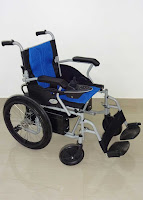Power wheelchairs are complicated devices. Using a power wheelchair can be overwhelming at first. Here are some tips to keep your chair in good condition and working for you!
START SLOW
- If you are a new power wheelchair user, take your time to familiarize yourself with the chair and how it operates. A power wheelchair has very powerful motors, and thus the power of the chair should be respected.
 |
| Our Price : Rs 62000 |
- Make sure you always drive the chair on smooth, even surfaces. Any bump over ½” can cause the chair to lose control easily. Also be aware of inclines as the Electric Wheelchair could tip over if you do not navigate inclines carefully. When going down steep inclines, you may find tilting the seat back (if you have that feature) slightly will make the ride more comfortable. Be aware that some chairs may “lock out” if tilted too far.
- Power wheelchair users should be particularly careful with cross slopes – slopes from left to right when facing the slope – as power wheelchairs are not designed to navigate much cross slope. If it looks steep to the eye – be aware!
- Picture of diamond shaped safety sign.
BASIC SAFETY
- When transferring in/out of the Power Wheelchair, turn the power off.
- Footplates and armrests are not designed to be weight-bearing surfaces and should not be used to take your weight when transferring. This can cause damage to the chair and possibly severely injure you.
- Power wheelchair joysticks are “proportional.” This means that the farther you push the joystick the faster it will go. Once you push the joystick all the way, it will not go any faster – do not put extra force on the joystick. Most chairs have some sort of speed control to limit the top speed that the chair will go. The speed and other features of the chair can be programmed to suit your needs. Contact your wheelchair provider for assistance in adjusting the speed.
- When the chair is stopped, the breaks automatically come on. The breaks will prevent the wheels from turning, even when the power is off. You cannot manually push a power chair unless you release the motors. Releasing the motors should only be done in the case of an emergency. A power wheelchair is very heavy, and you can quickly lose control of the chair if you are pushing it manually. If you look at the bottom of the chair, you will see release levers. Some chairs have one on each side, and some only have one. If you are not sure how to disengage the motors, call your wheelchair provider.
BATTERIES
- As you use the chair, you will have a regular charging routine. The chair should be charged when the battery indicator goes below 50% charge. If you leave the chair unused and not charging for an extended period of time, it will completely lose its charge. If this happens, the only option is to replace the batteries, which can be costly. (When in doubt, connect the chair to the charger!)
- You cannot over charge the chair. The charger will turn itself on and off as long as it is plugged in.
- The typical life expectancy of power wheel chair batteries is about three years. This is very dependent on how you use the chair. Some people will be able to get much longer use, others much shorter. If your batteries are not lasting for one day of typical use, call your wheelchair provider.
STORAGE
A power wheelchair should always be kept in a climate-controlled
environment. Extreme heat or cold will damage the batteries and the
electronics of the chair. A power wheelchair should not be stored out
of doors or in a garage (or other non-climate controlled space.)
picture of water faucet crossed out
GETTING THE CHAIR WET
A power wheelchair has electronics and batteries that can malfunction if
they get wet. Avoid crossing puddles in the chair that may splash
water onto the chair. Wrap a clear plastic bag over the joystick and
controller if you must drive in light rain. DO NOT OPERATE A POWER WHEEL CHAIR IN HEAVY RAIN.
BASIC MAINTENANCE
- Listen to the chair and become familiar with the sounds that it makes. If you notice that the chair is making any unusual noises, contact your wheelchair provider.
- On a regular basis keep the chair clean by wiping surfaces with a damp towel, using mild detergent when needed. Do not immerse any part of the chair in water. Special attention should be made to keep wheels and the bottom portion of the chair clean to avoid debris from damaging the wheels or motors.
- Do regular checks to make sure all wires and connections are securely connected and free of fraying. Notify your wheelchair provider if you notice anything out of the ordinary.








